Somerset House
| Somerset House | |
|---|---|
 The courtyard of Somerset House, from the North Wing entrance | |
 Location within central London | |
| General information | |
| Architectural style | Neoclassical |
| Location |
Strand London, WC2 |
| Country | United Kingdom |
| Coordinates | 51°30′39.7″N 0°07′01.9″W / 51.511028°N 0.117194°WCoordinates: 51°30′39.7″N 0°07′01.9″W / 51.511028°N 0.117194°W |
| Current tenants | Multiple |
| Construction started | 1776 |
| Cost | £462,323 (1801)[1] |
| Landlord | Somerset House Trust |
| Design and construction | |
| Architect | Sir William Chambers |
| Designations | Grade I listed building |
| Website | |
|
www | |
Somerset House is a large Neoclassical building situated on the south side of the Strand in central London, overlooking the River Thames, just east of Waterloo Bridge. The building, on the site of a Tudor palace, was designed by Sir William Chambers in 1776, and further extended with Victorian wings to the east and west in 1831 and 1856 respectively.[2][3] The East Wing forms part of the adjacent Strand campus of King's College London.[4]
History
Old Somerset House
16th century
In the sixteenth century, the Strand, the north bank of the Thames between the City of London and the Palace of Westminster was a favoured site for the mansions of bishops and aristocrats, who could commute from their own landing stages up-river to the court or down-river to the City and beyond.[5] In 1539 Edward Seymour, 1st Earl of Hertford (d.1552), obtained a grant of land at "Chester Place, outside Temple Bar, London"[6] from his brother-in-law King Henry VIII.[5] When his nephew the boy-king Edward VI came to the throne in 1547, Seymour became Duke of Somerset and Lord Protector.[5] In about 1549 he pulled down an old Inn of Chancery and other houses which stood on the site and began to build himself a palatial residence, making liberal use of other nearby buildings including some of the chantry chapels and cloisters at St. Paul's Cathedral, which were demolished partly at his behest as part of the ongoing Dissolution of the Monasteries. It was a two-story house built around a quadrangle with a gateway rising to three stories and was one of the earliest examples of Renaissance architecture in England. It is not known who designed the building.[7]
Before it was finished, however, the Duke of Somerset was overthrown, attainted by Parliament and in 1552 was executed on Tower Hill.[8][7] "Somerset Place" then came into the possession of the Crown. His royal nephew's half-sister the future Queen Elizabeth I lived there during the reign of her half-sister Queen Mary I (1553–1558).[7] The process of completion and improvement was slow and costly. As late as 1598 Stow refers to it as "yet unfinished".[9]
17th century
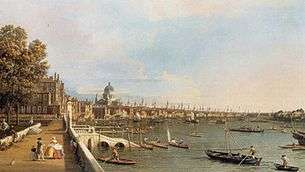
In the 17th century, the house was used as a residence by queens consort. During the reign of King James I, the building became the London residence of his wife, Anne of Denmark, and was renamed Denmark House.[10] She commissioned a number of expensive additions and improvements, some to designs by Inigo Jones.[11] In particular, during the period between 1630 and 1635 he built a Chapel where Henrietta Maria of France, wife of King Charles I, could exercise her Roman Catholic religion.[11] This was in the care of the Capuchin Order and was on a site to the south-west of the Great Court.[11] A small cemetery was attached and some of the tombstones are still to be seen built into one of the walls of a passage under the present quadrangle.[12]
Royal occupation of Somerset House was interrupted by the English Civil War and in 1649 Parliament tried to sell it. They failed to find a buyer, though a sale of the contents realised the very considerable sum (for that time) of £118,000.[13] Use was still found for it however. Part of it served as an Army headquarters, General Fairfax (the Parliamentary Commander-in-Chief) being given official quarters there;[14] lodgings were also provided for certain other Parliamentary notables. It was in Somerset House that Oliver Cromwell's body lay in state after his death in 1658.[15]
Two years later, with the Restoration, Queen Henrietta Maria returned and in 1661 began a considerable programme of rebuilding, the main feature of which was a magnificent new river front, again to the design of the late Inigo Jones, who had died at Somerset House in 1652.[16] However she returned to France in 1665 before it was finished. It was then used as an occasional residence by Catherine of Braganza, wife of King Charles II.[17] During her time it received a certain notoriety as being, in the popular mind, a hot-bed of Catholic conspiracy. Titus Oates made full use of this prejudice in the fabricated details of the Popish Plot and it was alleged that Sir Edmund Berry Godfrey, whose murder was one of the great mysteries of the age, had been killed in Somerset House before his body had been smuggled out and thrown into a ditch below Primrose Hill.[18]
Somerset House was refurbished by Sir Christopher Wren in 1685.[17] After the Glorious Revolution in 1688, Somerset House entered on a long period of decline, being used (after Queen Catherine left England in 1692) for grace and favour residences. In the conditions of the time this meant almost inevitably that little money could be found for its upkeep, and a slow process of decay crept in.[17] During the 18th century, however, the building ceased its royal associations. Though the view from its terraced riverfront garden, open to the public, was painted twice on his London visit by Canaletto (looking upriver and down), it was used for storage, as a residence for visiting overseas dignitaries and as a barracks for troops. Suffering from neglect, Old Somerset House began to be demolished in 1775.[17]
Somerset House (Sir William Chambers, 1776)
.jpg)
Since the middle of the 18th century there had been growing criticism that London had no great public buildings. Government departments and the learned societies were huddled away in small old buildings all over the city. Developing national pride found comparison with the capitals of the Continent disquieting. Edmund Burke was the leading proponent of the scheme for a "national building", and in 1775 Parliament passed an Act for the purpose of, inter alia, "erecting and establishing Publick Offices in Somerset House, and for embanking Parts of the River Thames lying within the bounds of the Manor of Savoy". The list of "Publick Offices" mentioned in the Act comprised "The Salt Office, The Stamp Office, The Tax Office, The Navy Office, The Navy Victualling Office, The Publick Lottery Office, The Hawkers and Pedlar Office, The Hackney Coach Office, The Surveyor General of the Crown Lands Office, The Auditors of the Imprest Office, The Pipe Office, The Office of the Duchy of Lancaster, The Office of the Duchy of Cornwall, The Office of Ordnance, The King's Bargemaster's House, The King's Bargehouses".[19]
Somerset House was still technically a royal palace and Crown property. By an earlier Act of Parliament, it had been placed in trust for the use of Queen Charlotte in the event that her husband the King predeceased her. Therefore the 1775 Act annulled this arrangement and instead provided for another property, Buckingham House, to be vested in trust for the Queen on the same terms. (Provision was made for the King, who had privately purchased Buckingham House some years earlier, to be duly compensated). In due course, the King outlived the Queen and the property (later known as Buckingham Palace) reverted 'to the use of His Majesty, his heirs and successors'.[20]
Construction
.jpg)
Sir William Chambers, Surveyor-General of Works was appointed at a salary of £2,000 p.a. to design and build the new Somerset House. He spent the last two decades of his life, beginning in 1775, in several phases of building at the present Somerset House. Thomas Telford, then a stonemason, but later an eminent civil engineer, was among those who worked on its construction. One of Chambers's most famous pupils, Thomas Hardwick Jr, helped build parts of the building during his period of training and later wrote a short biography of Chambers. By 1780 the North Wing, fronting the Strand, was complete; its design was based on Inigo Jones's drawings for the riverfront of the former building. Construction of the riverside wing followed; it was completed in 1786 and the East and West wings were occupied from 1788.[21]
It is not certain at what pace the rest of the construction progressed, but it is clear that the outbreak of war with France caused delays through lack of money. Chambers died in 1796, whereupon James Wyatt took over as architect. By 1801 the building was deemed to be complete,[21] but there are indications that as late as 1819 some decorative work still needed to be completed. The building (which did not yet include the "New Wing" and King's College London, situated behind the West and East Wings of the quadrangle respectively) cost £462,323.[21]
At that time of construction, the river was not embanked and the Thames lapped the South Wing where a great arch allowed boats and barges to penetrate to landing places within the building.[22] The design influenced other great buildings: Charles Bulfinch's Massachusetts State House, begun in 1795, has been described as a work "frankly derivative" of Somerset House.[23]
A home for arts and learning
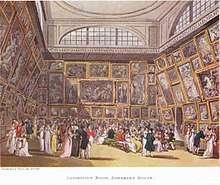
The North Wing of Somerset House was initially fitted out to house the Royal Academy, the Royal Society and the Society of Antiquaries. The Royal Academy took up residence first, in 1779, followed by the other two institutions the following year. The Royal Academy occupied the western half of the wing and the Royal Society the eastern half; their main entrances faced each other across the central vestibule leading from the Strand to the courtyard, topped by busts (of Michelangelo and Isaac Newton respectively) which are still in place today. The Society of Antiquaries was also accommodated in the eastern half of the wing, though its premises were limited to a first-floor meeting room, a ground-floor library, an apartment in the attic and a kitchen in the basement.[24]
The Geological Society was also accommodated in the Somerset House from 1828,[25] as was the Royal Astronomical Society from 1834.[26]
The annual Royal Academy Exhibition was held in Somerset House from 1780 onwards,[27] until the Academy moved out in 1837 (initially to rooms in the new National Gallery, then to Burlington House, Piccadilly). Its former accommodation was given over to a newly-established Government School of Design (which was much later to become the Royal College of Art); it remained in the complex from 1837 until, in 1853, the Registry of Births, Marriages and Deaths needed to expand its office space and the School relocated to Marlborough House.[28]
In 1857, the Royal Society moved out of Somerset House, followed in 1874 by the Society of Antiquaries, the Geological Society and the Royal Astronomical Society; they were all provided with new purpose-built accommodation in Burlington House.[21]
Use as a Government office
A key reason for rebuilding Somerset House was to provide accommodation for a diverse variety of government offices.[17]
Navy Office
In 1789 the Navy Board moved into grand riverside rooms in the western half of the newly-completed South Wing. It was soon followed by its subsidiary Boards, the Victualling Commissioners and the Sick and Hurt Commissioners, which (along with the Navy Pay Office) occupied the West Wing; they had all hitherto been based in the City of London. Thus the various Navy offices occupied around a third of Chambers' completed building.[29]
In 1832 the Navy Board and its subsidiaries were abolished and their departments placed under the direct oversight of the Admiralty. Their administrative staff remained in Somerset House, but communications with the Admiralty (based a mile away in Whitehall) were problematic as what became known as the 'civil departments' of the Admiralty guarded their independence. In 1868, the Admiralty took the decision to move all their staff from Somerset House to Whitehall; this necessitated reconfiguring what had been a set of residences there pertaining to the Lords Commissioners of the Admiralty into office accommodation.[30] Nevertheless, the move was completed by 1873, and the expanding Inland Revenue immediately took over the vacated space in Somerset House.[21]
Inland Revenue
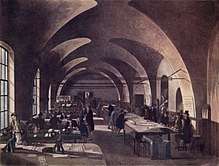
From the beginning of the new Somerset House there was a fiscal presence in the shape of the Stamp Office and the Tax Office, the former occupying the eastern part of the South Wing from 1789 and the latter occupying part of the East Wing. The Stamp Office had the task of applying an impressed duty stamp to various specific items to show that the required duty had been paid. For example, up until 1855 (when the relevant duty was abolished) every newspaper produced in the country had to be brought to Somerset House to be stamped.[31] The Tax Office administered and collected various taxes, including income tax (first levied in 1799). Introduced as a means of raising revenue in wartime, it was collected during the French Revolutionary Wars and the Napoleonic Wars; though repealed in 1816, it was reintroduced in peacetime (in 1842) and has been collected ever since.[32]
The Inland Revenue was created by a merger of the Stamp and Taxes Office and the Excise Office in 1849; in 1854 the Excise Office staff were moved from their old headquarters in the City of London into the newly-built New Wing.[33]
Somerset House continued in use by the Inland Revenue throughout the 20th century. In 2005, the Inland Revenue was merged with HM Customs and Excise; its successor HM Revenue & Customs continued to occupy much of the building, although its executive and senior management moved to 100 Parliament Street shortly after the merger. Various divisions and directorates of HMRC continued to occupy the East Wing until 2009, the West Wing until 2011 and the New Wing until March 2013, by which time all staff had been relocated (with most moving across the street to the south-west wing of Bush House). This brought to an end a 224-year association of the revenue services with Somerset House.[34]
Registry of Births, Marriages and Deaths
In 1837, following the establishment of civil registration in the United Kingdom, the Registrar General of Births, Marriages and Deaths set up his office in the North Wing of Somerset House, establishing a connection that lasted for over 130 years. This office held all birth, marriage and death certificates in England and Wales until 1970, when the Registry and its associated archives were moved to nearby St Catherine's House at Aldwych.[35]
Somerset House Laboratory
In 1842, the Excise Office had established a laboratory within its Broad Street headquarters for the prevention of the adulteration of tobacco products. It had started as basically a one-man operation by an employee of the Excise, George Phillips. After the Excise Office had been merged with the Office of Stamps and Taxes to form the Inland Revenue, the latter took over the laboratory; by 1858 it was re-established in Somerset House as the Inland Revenue Laboratory (with Phillips remaining in charge). It was also known as the Somerset House Laboratory. Under the Inland Revenue, the Laboratory's work expanded to encompass the testing of many different substances, including food, beer and spirits, as well as tobacco.[36]
Phillips retired as principal chemist in 1874. Dr. James Bell was then the principal chemist of Somerset House Laboratory until his retirement in 1894.[37] He was replaced as principal chemist by Sir Thomas Edward Thorpe. At the same time, the Laboratory was amalgamated with a similar facility that had been established within HM Customs and it was renamed the Government Laboratory. In 1897, Thorpe moved the Government Laboratory from Somerset House to a new building of his own design.[38]
Other departments
In addition to the learned societies, the ground floor rooms of the North wing housed the Hawkers and Pedlars Office (on the west side) and the Hackney Coach Office, the Lottery Office, the Privy Seal and Signet Offices (on the east side).[39] The Hackney Coach commissioners had been established on a permanent footing in 1694,[40] while the Board of Commissioners of Hawkers, Pedlars and Petty Chapmen dated from 1698;[41] the latter was abolished in 1810 and its work taken over by the Hackney Coach Office until its abolition in 1831, whereupon responsibility for licensing both of hackney carriages and of travelling traders passed to the Stamp Office. The Lottery Office, established in 1779, was also abolished in 1831 and its residual business likewise passed to the Stamp Office.[42] The Signet Office was abolished in 1851 and the Privy Seal Office in 1884.[43]
One of the first occupants of the building had been the Duchy of Cornwall Office. It was accommodated in the East Wing along with the Tax Office and various Exchequer offices (including the Pipe Office, the Lord Treasurer's Remembrancer's Office and the Office of the Clerk of the Estreats). As early as 1795 the Exchequer was requesting that more space be made available; Sir John Soane was engaged to redesign their offices, and as part of the scheme the Duchy was relocated to another part of the east wing, prompting complaints from its officers.[44] Pipe rolls and other ancient records of the Treasury and Exchequer (which had been moved to Somerset House from the Palace of Westminster in 1793) remained stored in the basements until the establishment of the Public Record Office in 1838.[45]
The office of Lord Treasurer's Remembrancer ceased to exist in 1833 and the Pipe Office was abolished in 1834; however space in Somerset House continued to be at a premium: in 1854 an Act of Parliament was passed (the Duchy of Cornwall Office Act 1854) noting that the Duchy's rooms in Somerset House were now needed 'for the use of the Commissioners of Inland Revenue, whose present office is insufficient for the Business thereof, and adjoins the said Office of the Duchy of Cornwall'. The Act provided for the Duchy Office to move to new, purpose-built premises in Pimlico: now known as 10 Buckingham Gate, the building still serves as head office for the Duchy.[46]
The Commissioners for Auditing Public Accounts were also housed in the East Wing, as was the Duchy of Lancaster Office (having moved there from accommodation in Gray's Inn) until it moved in 1823 to new offices across the road in Lancaster Place.[47] The Surveyor of Crown Lands also had his office here until the early 19th century. The Salt Office initially occupied rooms in the West Wing, alongside the naval offices, but it was abolished in 1798 (administration of the salt tax having been transferred to the Board of Excise).[39]
During the 19th century Somerset House contained the offices of the Poor Law Commissioners (1834–47)[48] the Tithe Commissioners (1836–51)[49] and, from 1859 until 1998, the Principal Registry of the Court of Probate and its successors.[50]
19th century expansion
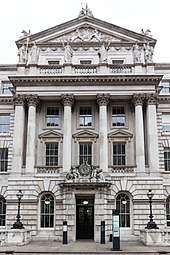
Magnificent as the new building was, it was something short of what Chambers had intended, for he had planned for additional wings to the east and west of the quadrangle. Cost had been the inhibiting factor. Eventually King's College London was erected to the east (the government granting the land on condition that the design conformed to Chambers' original design) by subscription between 1829 and 1834.[51]
Then, increasing demand for space led to another and last step. The western edge of the site was occupied by a row of houses used as dwellings for Admiralty officials who worked in the South Wing. Between 1851 and 1856 these were demolished and a further wing erected. 150 years later this part of the building is still known as the "New Wing".[52]
In 1891 a headquarters building was constructed in the West Court (between the West Wing and the New Wing) for the Civil Service Rifles, a Rifle Volunteer Corps.[53]
20th century modifications
.jpg)
By the start of the First World War the Civil Service Rifles, by then renamed the 15th (Prince of Wales' Own Civil Service Rifles) Battalion, The London Regiment,[54][55] had its own Morris tube firing range (where the calibre of the rifle is reduced for indoor operation by a use of a tube tube) fitted with vanishing and running targets at Somerset House.[56]
Somerset House had its share of trials and tribulations during the Second World War. Apart from comparatively minor blast effects at various times, sixteen rooms and the handsome rotunda staircase (the Nelson Stair) were completely destroyed in the South Wing, and a further 27 damaged in the West Wing by a direct hit in October 1940.[57]
Still more windows were shattered and balustrades toppled, but the worst was over by the end of May 1941. It was not until the 1950s that this damage to the South Wing was repaired. The work required skilled masons, whose services were hard to come by in the early post-war years. Sir Albert Richardson was appointed architect for the reconstruction. He skillfully recreated the Nelson Room and rebuilt the Nelson Stair. The work was completed in 1952 at a cost of (then) £84,000.[57]
In 1984 the Somerset House Act was passed, legislating the way for Somerset House to be redeveloped as a centre for the arts. In 1997 the Somerset House Trust was established as a charity to maintain the building and develop it as a centre for arts and culture.[34]
In the late 20th century the building began to be reinvigorated as a centre for the visual arts. The first institution to move in (in 1989) was the Courtauld Institute of Art, including the Courtauld Gallery, which has an important collection of old master and impressionist paintings. The Courtauld occupies the North Wing.[58]
Recent history

The main courtyard, which had been used as a civil service car park, and the main terrace overlooking the Thames were refurbished and opened to the public; these alterations being overseen by the conservation architects Donald Insall & Associates. Grants from the Heritage Lottery Fund financed the conversion of the South Wing between 1999 and 2003: a visitor centre featuring audio-visual displays on the history of the building, the gilded state barge of the Lord Mayor of the City of London and a shop and café were opened, overlooking the river. The Gilbert Collection of decorative arts, and the Hermitage Rooms, which stage exhibitions of items loaned from the Hermitage Museum in St Petersburg, moved into the same area.[59] The last Hermitage exhibition took place in 2007 and the Gilbert Collection galleries closed in 2008; the collection moved into new galleries at the Victoria and Albert Museum in June 2009. Somerset House now puts on a programme of art exhibitions drawing on various sources.[60]
In stages from 2009 to 2013, HM Revenue and Customs withdrew from the other parts of the building; since March 2013 the Somerset House Trust has had oversight of the entire complex. Its management policy has been to rent out the upper floors at a commercial rate to 'creative businesses' whilst devoting the ground floor to 'public realm' activities. The trust receives no public subsidy and relies on income from rent and private hire to fund the upkeep of the estate and relies on ticket sales, merchandising and sponsorship to fund its artistic and cultural programme.[34]
Somerset House is now residence to over a hundred tenants, comprising a large and diverse collection of creative organisations and artists including the British Fashion Council, 7Wonder, Hofesh Shechter Company and the Royal Society of Literature.[61] The largest tenant is King's College London whose Cultural Institute, Executive Centre and Dickson Poon School of Law occupy a large part of the East Wing. For a time the Representative of Anguilla (the diplomatic mission of the British Overseas Territory of Anguilla) was accommodated in part of the west wing.[62]

In the winter the central courtyard is home to a popular open air ice rink, as seen during the opening credits of the 2003 Christmas-themed film Love Actually.[63] At other times, an array of fountains display 55 vertical jets of water rising to random heights.[64]
The courtyard is also used as a concert venue.[65] A series of music events called the 'Summer series' are held in July each year. These have included performances from artists such as Lily Allen.[66]
Filming location
Somerset House is a popular filming location with its exterior featuring in several big budget Hollywood films. Among these include two James Bond films, Tomorrow Never Dies and GoldenEye,[67][68] and several scenes of the 2003 film, Shanghai Knights starring Jackie Chan and Owen Wilson were filmed in the courtyard of Somerset House.[69][70] The courtyard was also used in the 1991 comedy King Ralph.[71] Elements of the 2008 film The Duchess starring Keira Knightley and Ralph Fiennes were filmed in October 2007.[72] Somerset House was also used as a filming location in several Sherlock Holmes films, including the 1970 film The Private Life of Sherlock Holmes, and more recently, Sherlock Holmes (2009) starring Jude Law and Robert Downey, Jr. directed by Guy Ritchie.[73][74] Exterior shots of Somerset House were also used in the 1999 Tim Burton horror film, Sleepy Hollow starring Johnny Depp and the 2006 film, Flyboys.[75][76] It was used as a filming location in the 2012 Bollywood film Jab Tak Hai Jaan, starring Shah Rukh Khan, Katrina Kaif and Anushka Sharma, and directed by Yash Chopra.[77] Somerset House Courtyard was also used in the 2008 movie Last Chance Harvey with Dustin Hoffman and Emma Thompson.[78] Scenes were filmed in Somerset House in the Olympus Has Fallen sequel, London Has Fallen.[79]
Somerset House was also the main location for the BBC's New Year Live television show, presented by Natasha Kaplinsky, which celebrated the arrival of the year 2006.[80]
Gallery
 Somerset House in 1817, showing how the Thames originally flowed directly past the building.
Somerset House in 1817, showing how the Thames originally flowed directly past the building.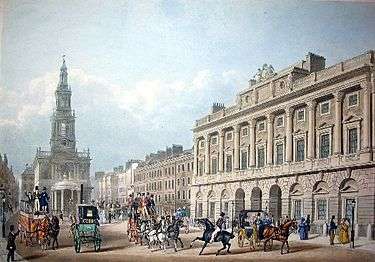 The Strand façade of Chambers' Somerset House and the church of St Mary-le-Strand, shown in a view of 1836
The Strand façade of Chambers' Somerset House and the church of St Mary-le-Strand, shown in a view of 1836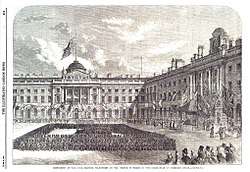 Courtyard view of the South and West wings in 1864.
Courtyard view of the South and West wings in 1864.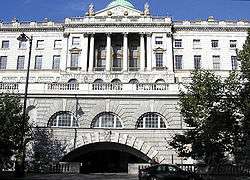 The river front of Somerset House today, seen from the Victoria Embankment.
The river front of Somerset House today, seen from the Victoria Embankment.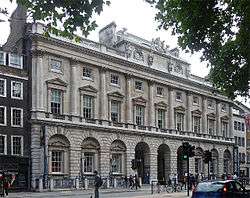 The Strand façade today.
The Strand façade today.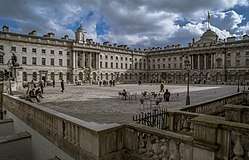 Courtyard view of the East and South wings today.
Courtyard view of the East and South wings today.
References
Notes
- ↑ "Since the 18th century". Somerset House Trust. Retrieved 27 February 2013.
- ↑ Humphreys (2003), pp. 165-6
- ↑ Somerset House Trust (2010), Annual Report (PDF), Somerset House Trust, p. 3, archived from the original (PDF) on 29 June 2012, retrieved 27 February 2013
- ↑ "Restoration of a Grade I listed Building" (PDF). WRAP. Retrieved 27 February 2013.
- 1 2 3 Thurley et al (2009), p. 9
- ↑

- 1 2 3 Thurley et al (2009), p. 11
- ↑ Who decided Edward Seymour, Duke of Somerset, should be executed?, retrieved 5 March 2018
- ↑ Stow, John (1598). "Survey of London". J M Dent And Sons. ISBN 978-1548852658.
- ↑ Thurley et al (2009), p. 13
- 1 2 3 Thurley et al (2009), p. 16
- ↑ "The Secret Gravestones Beneath Somerset House". Londonist. Retrieved 14 July 2018.
- ↑ Lindsay, Ivan (2013). The History of Loot and Stolen Art: from Antiquity until the Present Day. Unicorn Publishing. ISBN 978-1906509217.
- ↑ Thurley et al (2009), p. 31
- ↑ Thurley et al (2009), p. 25
- ↑ Thurley et al (2009), p. 48
- 1 2 3 4 5 Thurley et al (2009), p. 63
- ↑

- ↑ Crown Lands Act 1775
- ↑ 15 Geo.III c.33: An Act for settling Buckingham House, with the Appurtenances, upon the Queen, in case she should survive His Majesty, in lieu of His Majesty's Palace of Somerset House.
- 1 2 3 4 5 "History". Somerset House. Retrieved 20 March 2018.
- ↑ Thurley et al (2009), p. 68
- ↑ Shand-Tucci, Douglass. Built in Boston: City and Suburb, 1800-2000, p. 6. University of Massachusetts Press, Amherst, 1999. ISBN 1-55849-201-1.
- ↑ "The Strand Block of Somerset House, 1780-1836: Part II". History Today. Retrieved 21 March 2018.
- ↑ "History". The Geological Society. Retrieved 21 March 2018.
- ↑ "A brief history of the RAS". Royal Astronomical Society. Retrieved 21 March 2018.
- ↑ Thurley et al (2009), p. 75
- ↑ "Government School of Design (London)". Mapping Sculpture. Retrieved 14 July 2018.
- ↑ "Somerset House looking East". Royal Museums Greenwich. Retrieved 21 March 2018.
- ↑ Coad, Jonathan (2013). Support for the Fleet. English Heritage.
- ↑ Information panel
- ↑ "The Income Tax". Hansard. 21 March 1842. Retrieved 14 July 2018.
- ↑ Smith, Graham (1980). Something to Declare: 1000 years of Customs & Excise. London: Harrap & Co.
- 1 2 3 "Annual Report and Accounts 2014-15". Somerset House Trust. Retrieved 28 March 2018.
- ↑ "St. Catherine's House". Vital Certificates. Retrieved 14 July 2018.
- ↑ "Laboratory of the Government Chemist". Grace's Guide to British Industrial History. Retrieved 20 March 2018.
- ↑ "obit. Dr. James Bell, C.B., F.R.S." Nature. 77 (2006): 539–540. 9 April 1908. doi:10.1038/077539a0.
- ↑ "Thomas Edward Thorpe". Grace's Guide. Retrieved 14 July 2018.
- 1 2 Urban, Sylvanus (1807). "Somerset House". The Gentleman's Magazine and Historical Chronicle. 77: 545.
- ↑ "Vehicle registration and licensing records" (PDF). London Metropolitan Archives. Corporation of London. Retrieved 4 April 2018.
- ↑ Pedlars Act 1697
- ↑ "Lottery Office records". National Archives. Retrieved 4 April 2018.
- ↑ "Records of the Keeper of the Privy Seal". National Archives. Retrieved 4 April 2018.
- ↑ "London: Somerset House, Lords Commissioners of the Treasury: designs for alterations to offices, 1795". Sir John Soane's Museum Collection online. Retrieved 4 April 2018.
- ↑ Cooper, C.P. (ed.) (1837). Evidence ... before the Select Committee of the House of Commons, appointed 'to inquire into the management of the Record Commission and the present state of the records of the United Kingdom'. London: House of Commons. p. 205.
- ↑ Architectural drawing
- ↑ "Records of the Duchy of Lancaster". National Archives. Retrieved 4 April 2018.
- ↑ "Records of the Poor Law Commission, Poor Law Board and Poor Law Department of the Local Government Board". National Archives. Retrieved 5 April 2018.
- ↑ "Somerset House. Tithe Commission Office. Plans & Elevation Of the Proposed Additions". National Archives. Retrieved 5 April 2018.
- ↑ "Somerset House: Court of Probate. Elevation of New Principal Registry". National Archives. Retrieved 5 April 2018.
- ↑ "Westminster City Council resolves to grant planning permission for Strand redevelopment". 23 April 2015. Retrieved 14 July 2018.
- ↑ "New Wing". Somerset House. Retrieved 14 July 2018.
- ↑ "Somerset House: West Court - Civil Service Volunteers Building". National Archives. Retrieved 5 April 2018.
- ↑ "15th (Prince of Wales' Own Civil Service Rifles) Battalion, The London Regiment". Wartime memories. Retrieved 14 July 2018.
- ↑ "City of Westminster". Stepping Forward. Retrieved 14 July 2018.
- ↑ "Anatomy of a drill hall". Retrieved 14 July 2018.
- 1 2 "Plan for the Reconstruction of the South Wing of Somerset House, London". Stephen Onping Fine Art. Retrieved 14 July 2018.
- ↑ Thurley et al (2009), p. 85
- ↑ "Hermitage Rooms at Somerset House". Cultural Innovations. 2009. Archived from the original on 20 June 2013. Retrieved 27 February 2013.
- ↑ "Somerset House". Time Out London. Retrieved 27 February 2013.
- ↑ "Residents". Somerset House. 2016-08-29. Retrieved 2017-11-24.
- ↑ "The London Diplomatic List" (PDF). 14 December 2013.
- ↑ "The Big Skate: outdoor ice rinks in London". BBC. 25 November 2009. Retrieved 27 February 2013.
- ↑ Humphreys (2003), p. 166
- ↑ Somerset House - Music Archived 19 June 2008 at the Wayback Machine.
- ↑ Thurley et al (2009), p. 123
- ↑ "Tomorrow Never Dies (1997)". British-Film-Locations.com. Retrieved 28 February 2013.
- ↑ "Goldeneye (1995)". British-Film-Locations.com. Retrieved 28 February 2013.
- ↑ "Shanghai Knights (2003)". British-Film-Locations.com. Retrieved 28 February 2013.
- ↑ "Shanghai Knights (2003)". British-Film-Locations.com. Retrieved 28 February 2013.
- ↑ "Where was King Ralph filmed?". British Film Locations. Retrieved 31 October 2017.
- ↑ "Duchess, The (2008)". British-Film-Locations.com. Retrieved 28 February 2013.
- ↑ "Private Life Of Sherlock Holmes, The (1970)". British-Film-Locations.com. Retrieved 28 February 2013.
- ↑ "Sherlock Holmes (2009)". British-Film-Locations.com. Retrieved 28 February 2013.
- ↑ "Sleepy Hollow (1999)". British-Film-Locations.com. Retrieved 28 February 2013.
- ↑ "Flyboys (2006)". British-Film-Locations.com. Retrieved 28 February 2013.
- ↑ Steven Baker (23 September 2012). "'Jab Tak Hai Jaan' London film locations revealed". Digital Spy. Retrieved 28 February 2013.
- ↑ "Dustin Hoffman and Emma Thompson filming on South Bank". London SE1. 21 May 2008. Retrieved 14 July 2018.
- ↑ "Gerard Butler spotted speeding down Strand in filming of action thriller". 8 March 2015. Retrieved 31 March 2015.
- ↑ "Somerset House, The Portico Room". Pole Structural Engineers. Retrieved 28 February 2013.
Bibliography
- Borer, Mary Cathcart The City of London: A History. New York: McKay, 1977 (pp 156)
- Humphreys, Rob (2003). The Rough Guide to London (5 ed.). Rough Guides Ltd. pp. 165–6. ISBN 1843530937.
- Stow, John A Survey of London. Reprinted from the Text of 1603. Ed. Charles Lethbridge Kingsford. 2 vols. Oxford: Clarendon, 1908 (2:394-5
- Thurley, Simon; et al. (2009). Etherington-Smith, Meredith, ed. Somerset House: The History. Somerset House Trust/Cultureshock Media. ISBN 978-0956266903.
External links

- Official website of Somerset House
